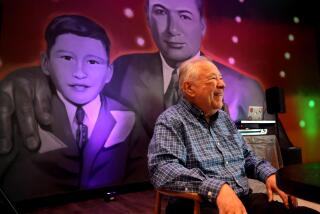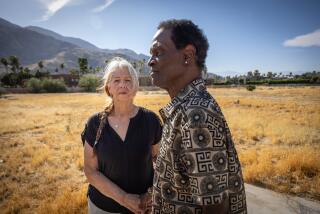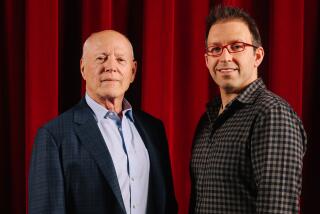HOME SCREEN ADVANTAGE
The mighty Titanic was going under, passengers were jumping overboard and the ship’s string quartet was playing.
Suddenly, a woman seated in a crowded section of the Baldwin Hills Crenshaw Plaza’s movie complex shouted at the screen:
“Forget playing! I’d get my ass in one of those lifeboats.”
The comment brought a moment of laughter, the kind of audience participation that moviegoers have come to expect at the 12-screen Magic Johnson Theatres.
The complex, in the center of Los Angeles’ largest middle-class African American community, has developed a profound identity with its primarily black audiences since it opened in 1995. It is more than a place where audiences feel free to talk back to the screen.
It’s a mecca for African Americans who prefer to laugh at “Soul Food” or experience the anger of “Amistad” in an environment where nuances unknown in other cultures are instantly grasped.
It’s a place where blockbusters like “Titanic” play next to critically acclaimed low-budget films like “Eve’s Bayou.”
It’s the place where directors who traffic in films with African American themes or contexts come to gauge audience reaction.
Quentin Tarantino was there on Christmas Day, watching the opening-day showing of his hit film “Jackie Brown,” a tribute to the blaxploitation films of the ‘70s.
“I couldn’t imagine seeing it anywhere else,” said the director, shaking hands with admiring moviegoers outside the complex afterward.
With this success in his pocket, entrepreneur Earvin “Magic” Johnson and his partner, Sony/Loewes Theatres Corp., are planning movie complexes in primarily black upscale neighborhoods in other U.S. cities. They already operate a 12-screen theater in Atlanta, and others are under construction in Houston and Carson, which has a substantial black population.
Part of what they’ll be selling are moments like the one that occurred when “Waiting to Exhale” screened at the Crenshaw theater.
Angela Bassett, playing the role of a devoted wife whose husband dumped her for another woman, had gathered his clothes, stuffed them in his BMW and poured fuel on top. She lit a cigarette and contemplated the contents.
“Burn it! Burn it! Burn it!” women in the audience shouted as men, cringing at the thought, shouted, “No!” Bassett tossed the match on the mound, turned and walked away as the car exploded. Women applauded, and men settled in for a long, difficult show.
“The Magic Johnson theater is one of those institutions in the black community that has a very specific vibe--like the black church, the barber shop and the beauty parlor--where an oral tradition thrives,” says Todd Boyd, a professor of critical studies in the USC School of Cinema-Television.
Living and working in Beverly Hills, Linda Wallace Pate, an attorney, bypasses theaters much closer to home to travel to the Magic.
“I need to see the hairstyles, the outfits,” said Pate, who is black and grew up in the segregated South. “I need that sense of connection.”
She recalled a scene in the John Singleton movie “Rosewood” in which black children in the 1920s were running, trying to get on a train to escape white racists who were trying to kill them.
“When the last child got on the train, there was a sigh. You could touch the excitement in the audience,” she said. “It was very powerful. No one said anything, you could just feel it.”
This was the potential that Johnson saw after he retired from the Los Angeles Lakers in 1991 and committed himself to a career as a businessman. In choosing the Crenshaw district for his first theater complex, he moved into an area that many had abandoned or written off as too risky.
The joint venture with Sony draws 1.3 million moviegoers--and potential shoppers--each year to the plaza and has also become a cultural enclave for black entertainment, seminars and community forums.
“Magic was a pioneer,” said Jack Kyser, an economist at the L.A. County’s Economic Development Corp. “That theater has had an amazing impact on the area around it. It is the key that has unlocked the door to a lot of economic potential.”
There is a sense of pride in having a first-class theater in a neighborhood that is often shunned by major retailers, said Karen Grigsby Bates, an author and columnist who lives in the area.
“We read books, go to the movies and eat out,” she said. “We need decent places in the community, and the Magic--as it is called--provides one of those things.”
Management makes a strenuous effort to make customers feel part of the theater. Before each film, a smiling Johnson promises in a promotional clip that “from the person selling popcorn to the men and women in charge, this theater is a local effort and you are part of the team.”
“You walk into the theater and everyone from the security guard to the concession stand greets you, ‘Welcome to the Magic theater. Hope you have a good time,’ ” Bates said. “You don’t get that in Century City.”
Not all businesses in the Crenshaw mall have benefited as a result of the increased foot traffic the theater complex generated. Some clothing stores and a couple of upscale restaurants have closed their doors amid complaints that the theater’s audience is primarily young.
“We draw the people, but we can’t sell the goods for them, we can’t do the marketing and sales jobs for them,” responds Kenneth Lumbard, president of Magic Johnson Theatres.
The Magic was what the organizers of Los Angeles’ Pan African Film Festival were searching for--a way to tap into the large black middle class in the surrounding neighborhoods--when they moved their annual event there from Hollywood three years ago.
“The black middle class feels that this is their theater, so we had to be here,” said the festival’s executive director, Ayuko Babu.
The festival, running through Monday, features more than 60 films, varying visions of Africans and African Americans, films that range from “‘Black Orpheus,” the Afro-Brazilian cinema classic, to “Fakin’ Da Funk,” the story of a Chinese boy adopted into an African American family in South-Central Los Angeles. The festival also includes an art exhibition and a series of panel discussions.
In building the theater, Johnson said he was trying to answer one of the pressing needs in urban areas. Simply put, he said: “People have been looking for a place to see a movie, hang out and socialize without leaving their community.”
Inside the multiplex, there’s a mural tracing Magic’s career, from his days at Michigan State to the Lakers and now as an entrepreneur. On another wall, visitors see a “Wall of Fame” depicting historic black figures in the entertainment industry: Paul Robeson, Lena Horne, Richard Pryor, Eddie Murphy and Esther Rolle.
There are also frank warnings aimed at preventing the kinds of problems that made other theater developers nervous about locating in urban areas: no hats, no colors associated with street gangs. “If there is a problem,” Johnson says in his introductory film clip, “leave it on the street.”
The rules have ruffled some feathers. In a Los Angeles Times essay shortly after the complex opened, sociologist Earl Ofari Hutchinson complained they were based on “the media-driven image of black neighborhoods as gang-ridden zones, where anarchy reigns and productive families don’t exist. The majority of South-Central residents take pride in their homes, their jobs and their community. Most young blacks in the area do not join gangs or deal drugs.”
Today, Hutchinson is less bothered by the operating conditions. “The security is not as heavy-handed,” he said.
Lumbard said the company has set a fine line when it comes to behavior--whether in dress or even talking back to the screen.
“We have attempted to create an environment where not only members of the community but everyone who patronizes us see the theater as their home away from home, where everyone feels welcomed.”
To do that, he said, “we know what is positive and we know what is disruptive--we maintain the line between the two. If we feel something is disruptive, if patrons feel uncomfortable, then we have absolutely no tolerance for that.”
USC professor Boyd thought he had his own way of avoiding movie chatter. He skipped the opening of “Amistad” at the Johnson complex and waited for the first morning show the next day--only to find the ticket line out the door and into the street.
You don’t get that in Century City, either.
More to Read
The biggest entertainment stories
Get our big stories about Hollywood, film, television, music, arts, culture and more right in your inbox as soon as they publish.
You may occasionally receive promotional content from the Los Angeles Times.










